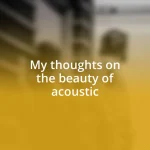Key takeaways:
- Understanding electronic music involves grasping the elements of rhythm, melody, harmony, and texture, which collectively evoke emotional responses.
- Key tools for music production include digital audio workstations (DAWs), MIDI controllers, and plugins that can greatly enhance creativity and sound quality.
- Finding a unique sound requires experimentation with genres, embracing imperfections, and critically listening to your own work for growth and self-discovery.

Understanding electronic music elements
When I first immersed myself in electronic music, I was struck by the vast array of sounds that could be crafted through the manipulation of basic elements like rhythm, melody, and harmony. It’s fascinating how these components intertwine to create complex layers of sound that evoke different emotions. Have you ever noticed how a simple beat can transform your mood? That’s the magic of rhythm in electronic music; it sets the foundation and drives the energy of a piece.
Melody is another pivotal element, often serving as the soul of a track. I remember the first time I heard a soaring synth lead that just resonated with me—it felt like it was speaking directly to my heart. It makes me wonder, what is it about a melody that can stir such deep emotions within us? It could be the choice of notes, the way they’re arranged, or even the timbre of the sound itself that draws listeners into a unique emotional experience.
Finally, let’s not overlook texture, which brings depth and richness to electronic music. The layering of sounds, from lush pads to sharp stabs, creates a tapestry that envelops the listener. In my experience, this complexity invites me to explore the music repeatedly, each listen revealing new nuances and surprises. How many times have you replayed a favorite track, only to discover a hidden sound that seems to appear for the first time? That’s the beauty of electronic music elements coming together—they create a dynamic listening experience where there’s always something new to discover.

Key tools for music production
When it comes to producing electronic music, the right tools can make all the difference. I’ve often found that using a digital audio workstation (DAW) like Ableton Live or FL Studio allows me to get into the groove quickly. These platforms provide a canvas where I can experiment with sounds—a bit like painting, but with audio. Do you remember the excitement of discovering a new piece of software? That rush sparked, for me, countless late-night sessions filled with creativity.
Beyond just software, having quality hardware can greatly enhance the production experience. For instance, MIDI controllers have become my best friends in the studio. The tactile feel of knobs and pads encourages a hands-on approach, making it easier to bring my musical ideas to life. Have you ever felt that satisfying connection between your fingers and the sound you’re creating? It’s incredibly rewarding when the equipment becomes an extension of your passion, guiding you through the creative process.
Finally, let’s not underestimate the importance of plugins. I can’t count how many times a single plugin transformed an average track into something brilliant. From synths to effects like reverb and delay, these tools open up a world of sonic possibilities. I still vividly remember the first time I used a granular synth and noticed how it could warp sounds into entirely new shapes. It was almost like unlocking a secret door to a hidden realm of creation.
| Tool Type | Examples |
|---|---|
| Digital Audio Workstations (DAWs) | Ableton Live, FL Studio, Logic Pro |
| MIDI Controllers | Akai MPK Mini, Novation Launchkey |
| Plugins | Serum, Omnisphere, Valhalla Room |

Techniques for sound design
When diving into sound design, I’ve discovered that experimentation is key. Playing around with different waveforms can lead to incredible discoveries. I vividly remember the first time I tweaked a basic saw wave, layering effects like distortion and filter sweeps. It felt like I was sculpting sound out of raw clay, and the possibilities seemed endless. Have you ever found yourself lost in the creative process, where time disappears as you chase that perfect sound?
Here are some techniques that have worked for me in sound design:
- Layering Sounds: Combine different sounds for fullness and depth. I often mix kick drums with hand claps for a punchy rhythm.
- Modulation: Use LFOs (Low-Frequency Oscillators) to add movement. This method can transform a static sound into something dynamic and engaging.
- Resampling: I’ll often take a sound, process it through effects, and then re-record it. This approach yields unexpected textures that can breathe life into a track.
- Use of Ambience: Incorporating environmental sounds—like birds chirping or city noise—adds a relatable layer that draws listeners in.
- Synth Programming: Crafting your own patches instead of relying on presets makes the sound uniquely yours. I love the thrill of discovering a new timbre that speaks to my style.
Every time I explore these techniques, I feel the rush of creativity surging back. What about you? Have you found a technique that makes you excited to create?

Arranging tracks effectively
When arranging tracks effectively, I often start by considering the overall flow and energy of the piece. I remember one time I spent hours tweaking the order of my elements, trying to find the perfect build-up. It’s fascinating how seemingly small changes can shift the entire mood of a track, right? I always aim to create a journey for the listener—something that takes them from anticipation to joy and back again.
One technique that has proven invaluable is using templates in my DAW. Before diving into a new track, I often set up a template that outlines the arrangement structure I like to use. This not only saves time but also sparks my creativity by providing a solid foundation. Have you ever noticed how having a framework can free you up to experiment more boldly? I’ve found that with a little structure in place, my ideas flow more seamlessly, allowing me to focus on the nuances of sound rather than getting lost in organization.
Additionally, breaking the track into sections—like verses, choruses, and bridges—has helped me maintain interest and variety. I recall a project where I experimented with unconventional transitions, using silence to build tension before a drop. It was exhilarating to witness how the absence of sound made the subsequent moment that much more impactful. Do you think pushing the boundaries of traditional arrangements can lead to exciting new sounds? In my experience, it absolutely can!

Mixing and mastering basics
Mixing and mastering is an art that can elevate a track from good to outstanding. I remember sitting at my desk, meticulously balancing levels for the first time and feeling like a conductor guiding an orchestra. There’s something immensely satisfying about adjusting the volume faders just right so that every element sits perfectly in the mix. It’s as if you’re bringing out the hidden colors of a painting, creating a richer auditory experience.
A fundamental step I always emphasize is EQ (equalization). This tool allows me to carve out space for each instrument so they don’t clash. For instance, I often find myself rolling off unnecessary low frequencies from synths to let the kick drum punch through. Have you experienced how a cleaner mix can transform the energy of a track? I know it’s often the small details that make the biggest difference, and EQing certainly highlights that.
When it comes to mastering, I make it a priority to maintain dynamics while maximizing loudness. My first attempt at mastering was a bit of a roller coaster, where I learned the dangers of compressing too much. I’ll never forget the moment I heard my track on different speaker systems and realized how vital it is to ensure that even subtle nuances are preserved. Have you ever felt a track come alive under mastering, revealing hidden depth? That experience has genuinely shaped how I approach the final touches of my music.

Performance tips for live shows
One crucial tip for live shows is to rehearse like you mean it. I remember feeling a rush of adrenaline during my first rehearsal with a full setup, realizing that knowing the equipment inside and out made all the difference. It’s essential to practice not just the music but also how to interact with the audience. Have you ever noticed how a confident performer draws people in? I’ve found that the energy you project can create a powerful connection with the crowd, enhancing everyone’s experience.
Another aspect I always prioritize is having backup gear ready. Early on, I didn’t think it was necessary until the night of an important show when my laptop crashed mid-set. The panic I felt made me vow to always carry spare cables and an extra controller. Trust me, you don’t want your creativity to be hindered by technical difficulties. Have you ever been caught unprepared during a performance? Being ready for anything can soothe those nerves and allow your creativity to shine.
Lastly, I love to feed off the crowd’s energy. I recall a memorable performance where I noticed the audience vibing to an unexpected remix choice I made. Instead of sticking strictly to the setlist, I engaged with them, letting their excitement guide my decisions. How often do we underestimate our audience’s impact on our performance? In my experience, the magic happens when you embrace spontaneity and allow the moment to guide you.

Finding your unique sound
Finding your unique sound starts with exploring various genres and styles. I vividly remember when I first experimented with combining elements from both techno and ambient music. The result was a track that was unlike anything I had created before. Have you ever stumbled upon a combination that surprised you? That moment sparked a journey of self-discovery for me as I realized how blending different influences could lead to a distinct musical identity.
I’ve learned that embracing imperfections can also play a key role in sculpting your sound. One of my most cherished tracks included a happy accident – a stray note from a forgotten synth line that somehow fit perfectly. It reminded me of how the essence of my music often lies in the unexpected. Have you considered how moments of spontaneity can shape your own creations? Every little imperfection can become a stepping stone toward something uniquely yours.
Listening critically to your own work is crucial as well. I often find it helpful to step away from a piece for a bit before returning with fresh ears. I once revisited an old track and discovered how much it reflected my artistic journey at that time. What new insights will you uncover when you do the same? It’s through this kind of reflection that I’ve been able to refine my sound and truly communicate who I am as an artist.













